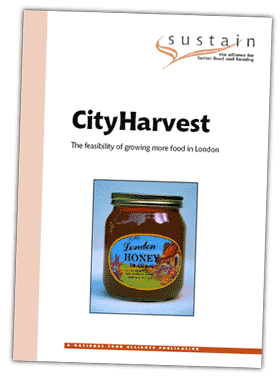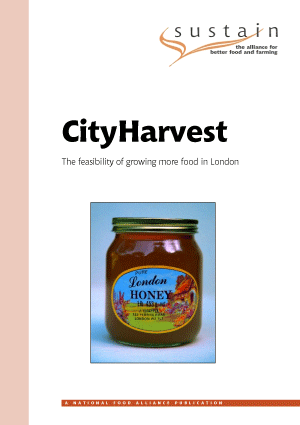City Harvest: The feasibility of growing more food in London
 This report looks at the feasibility of food production in cities. It takes London as its example, but is relevant to all urban areas.
This report looks at the feasibility of food production in cities. It takes London as its example, but is relevant to all urban areas.
This report forms part of the City Harvest project, an initiative managed by Sustain: The alliance for better food and farming. Since 1997 City Harvest has worked to promote, develop and research the potential for food growing activities in London as a means of contributing to its social, economic and environmental regeneration.
The 176-page publication covers urban food systems and an overview of existing food growing activities. With inspiring examples and case studies from the UK and abroad, the report presents a conclusion and detailed recommendations, and includes maps, a glossary, and sources of more information.
"London could become a pioneer of urban agriculture for the UK, and even for Europe. The breadth and depth of expertise in the capital is impressive and, with a supportive policy framework, could significantly improve the quality of urban living."
Progress update
Since this City Harvest report, and the earlier Growing Food in Cities publication, Sustain and London Food Link have launched the Capital Growth campaign, aiming to support the creation of 2,012 new community food growing spaces for London by the end of 2012. In addition, Sustain launched in 2012 the Big Dig campaign to promote volunteering and community food growing in seven cities around the UK. We have also supported community food growers through the Making Local Food Work and Ethical Eats programmes to take an enterprising approach to growing and selling urban food, with publications such as:
- A Growing Trade: A guide for community groups growing food to sell in our towns and cities
- A Healthy Profit: A simple guide to pricing the food you make or grow
- The story of Moss Brook Growers - how to set up a horticultural enterprise from scratch
- Growing Manchester(s) Veg People - a guide to setting up a growers' and buyers' co-operative
- Growing Communities: manual of monitoring and evaluation
- Information Technology and small-scale food organisations: Is IT a nightmare?
- Growing Round the Houses: Food production on housing estates
Report contents
Summary
1) London: An introduction
- Elusive definitions: urban agriculture; London
- London’s characteristics: health; the environment
- London’s food system: environmental impact; the food economy; food and health; social exclusion; food and culture
2) Urban agriculture
- The current situation: commercial farm land; county farms; allotments; city farms and community gardens; school gardens; orchards; parks; private gardens
- Who’s involved in urban agriculture? gardeners; organisations; the global picture
3) The environment
- The current situation
- The potential: biodiversity;waste; packaging; homecomposting; other composting options; sewage; the future for waste; food miles
4) Economic development
- The current situation: the cash value of locally grown food; alternative measures of value
- The potential: production; animals; horticulture; honey; mushrooms; fish; processing and marketing; farmers’ markets;
- Women’s Institute markets; Local Exchange Trading Schemes; box schemes; public institutions; allotment sites; commercial retailers: composting organic and sewage waste; standards; promotion; sewage; ancillary industries
5) Health
- The current situation
- The potential: healthy neighbourhoods; healthy schools; healthy workplaces
Case studies
Map
‘Bringing it all together’
6) Community development
- The current situation: individuals; communities; crossing boundaries
- The potential: regenerating the area; building local structures; promoting citizenship; unemployed people; young people; senior citizens; children; employees
7) Education and training
- The current situation
- The potential: school learning; the new curriculum; learning for all; learning for work;
8) Sustainable land use
- The current situation
- The potential: the urban fringe; built up areas; parks; housing estates; allotments; ‘meanwhile’ land; soil contamination; soil testing; tackling the problem
9) How much could London produce?
10) Conclusion
- Recommendations
- Local statutory agencies; The Greater London Authority;
- National Government; Business; Voluntary organisations
Appendices
- Theory and reality: The City Harvest project - project management and funding; publicity; development work; the research; international connections; the future
- Glossary
- Contacts in five London Boroughs - Tower Hamlets, Hackney, Ealing, Kensington and Chelsea, Hillingdon
- Useful information

City Harvest: The feasibility of growing more food in London
ISBN: 1 903060 01 X - 176pp - 1999 | 1982Kb
Published Friday 1 January 1999
London Food Link: London Food Link brings together community food enterprises and projects that are working to make good food accessible to everyone in London to help create a healthy, sustainable and ethical food system for all.